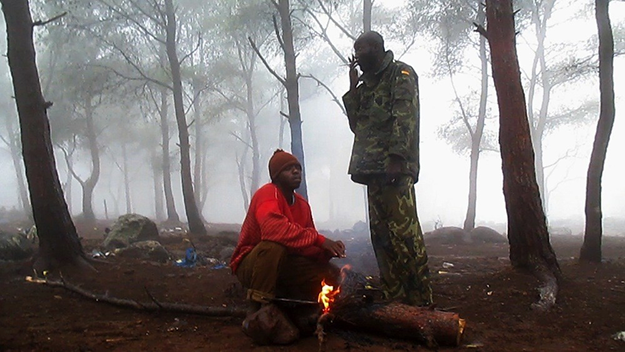Make It Real: Look Ma, We’re All Hands
Starless Dreams
It’s often there, just above the frame, but you don’t really think about it. Even in documentaries there’s a suspension of disbelief, our attention focused on what’s visible within the box. Yet in a casually crucial moment in Starless Dreams, by Iranian filmmaker Mehrdad Oskouei, the normally invisible boom mic not only becomes visible, it’s temporarily re-commissioned as a pop-star accessory. A teenage female prisoner in a Tehran detention center derails a sober conversation to acknowledge the bulbous cylinder looming inches above her head, then breaks into song as if she were auditioning for Iranian Idol. Soon her fellow detainees join in, singing and poking fun at the interloping machinery, affirming that one tool of capturing has been captured—or at least detained—and ensuring that we won’t soon forget that it’s there.
What’s remarkable about this moment is not that the fourth wall has been breached, or that the audience has been disabused of their illusions about the filmmaking process—it’s the ease of the filmmaker-subject interplay. Including this interaction doesn’t come across as a concession—Oskouei’s work, as evidenced here and in the companion film, The Last Days of Winter, is too outward facing and urgently empathetic to dwell on its own anxieties—but rather an affirmation that such exchanges are typical, complex, and crucial. Here and elsewhere in the movie, the distinction between filmmaker and his subjects is acknowledged, yet in a sincere and playful manner that actually brings them closer to each other, and us to them. With all illusions of directorial omnipotence out of the way, we can all participate more honestly and fully.
At this year’s True/False Film Fest—the sixth I’ve attended and the filthiest with where-did-this-come-from discoveries, the previously unknown-to-me Oskouei foremost among them—moments like this abounded. Acknowledgments of the filmmaking process, of the collaborations between on- and off-screen participants, of the power dynamics in play, were present without overwhelming the larger project; and they were substantive enough to not be perfunctory. It’s as if the heart of festival selection Cameraperson, with its feature-length exploration and interrogation of what the camera reveals and conceals about both its holder and the beheld, was coursing throughout the festival’s circuitry. It flowed essentially but not ostentatiously, provocatively but also matter-of-factly. Laying bare the filmmaking process wasn’t an end in itself, but a threshold to places unfamiliar and unarticulated.
Nosotras · Ellas
In Julia Pesce’s Nosotras · Ellas, an atmospheric, often obtuse portrait of a close-knit all-female household in Argentina, a swimming expedition to a nearby river includes a brief shot of one of the subjects filming back at us, which pays off later when we are shown her footage. It’s a satisfying alternation of point of view, as well as a peek behind the film’s otherwise restrained camera, but it’s also an essential reveal: the person who’s been making Nosotras looks a lot like the women she’s been shooting. That revelation doesn’t simplify or solve for what we’ve been watching—it’s not an “aha, that makes sense” moment—but rather complicates things, since most of what we’ve been watching has seemed, in spite of access to intimate moments and spaces, less engaged than observational. Discovering that Pesce is related to these women actually makes her filmic relationship to them more mysterious.
I wouldn’t call what happens between Andreas Horvath and his eponymous subject in Helmut Berger, Actor mysterious, but it’s not exactly fathomable either. From the start, the aging Austrian movie star speaks directly to Horvath, but the nature of his discourse, and that of Horvath’s responses, veer from needy to antagonistic, performative to naked, quotidian to pornographic. It’s all reflective of Berger’s essentially mercurial persona and well-honed media-baiting bullshit, which makes his intersection with the mostly permissive Horvath the film’s X-factor. That there’s a person behind the camera gets addressed within moments, migrating the real tension to how the person behind the camera can put up with this wickedly compelling monster, and what he’ll elect to endure in order to expose the monster to us. Horvath is a direct recipient of distemper, moral accusations, physical threats, verbal abuse, and overt seduction. It’s how Horvath reacts and relents to Berger’s varied advances, whether he allows or denies his transgressions, that his portrait acquires definition, delineating the contours of his subject’s desperation. But it’s a desperation that’s always, in some way, performed, whereas Horvath’s gaze seems sincere, if also occasionally, and probably reluctantly, withering. Here the subject’s life isn’t the primary locus of exploitation, but rather the filmmaker’s tolerance. Tellingly, even as Berger ends up with his own cock in his hand, literally and figuratively getting himself off, it’s what Horvath is doing, abiding, and showing Berger from behind the camera that rules the scene.
In the singular and seemingly impossible Those Who Jump, the line between subject and filmmaker is more like a jagged, intricate, multi-sided geometric shape. German filmmakers Moritz Siebert and Estephan Wagner bequeathed a small camera to ostensible subject Abou Bakar Sidibé, a Malian man camped on a Moroccan hillside along with hundreds of other Africans, waiting for the right moment to emigrate to Europe via a series of dangerously high fences separating the continent from the Spanish enclave of Melilla. Giving the camera to Sidibé yielded Siebert and Wagner footage they never could have acquired otherwise, and of a sort that they never could have obtained if they were present. But in leaving the apparatus entirely in Sidibé’s hands, the movie becomes his. Gradually, over the days and weeks of his stay in the camp, he grows into a filmmaker before our eyes. His techniques of framing and shooting evolve, as does his construction of scenes. He learns to track movement, he gets interested in the landscape and in the possibilities of expressing experience through visual metaphor.
Those Who Jump
Despite whatever direction he was receiving from Siebert and Wagner from afar, he’s substantively both the film’s central subject and its sole chronicler. All three are credited as directors, while Wagner edited Sidibé’s footage into the finished film, but here’s a situation where credits feel like an outmoded concept. The idea is to describe the experiences of people living in an in-between state, literally on the fringe of civilization—on the fringe of our conception of what the fringe of civilization could even mean—and it requires a method that’s on the fringe of what we know as filmmaking. Until, that is, our conduit, an ingenious conceptual solution to the problem of documentary access, transforms into something unmistakably and gloriously familiar—an artist.
Who’s exploiting whom, who’s truly making these realities visible, how do we distinguish between complicity, collaboration, participation, and objectivity, who’s on what side of the camera and what does it mean—these are fathomless queries, ungraspable prey, infinitely and mutably applicable. But there’s something suitably new about how these issues play out in Those Who Jump. In its wholly novel account of a geographical border’s dangerous transgression, it renders certain filmmaking boundaries not transgressed, stretched, or bent, but utterly moot.










